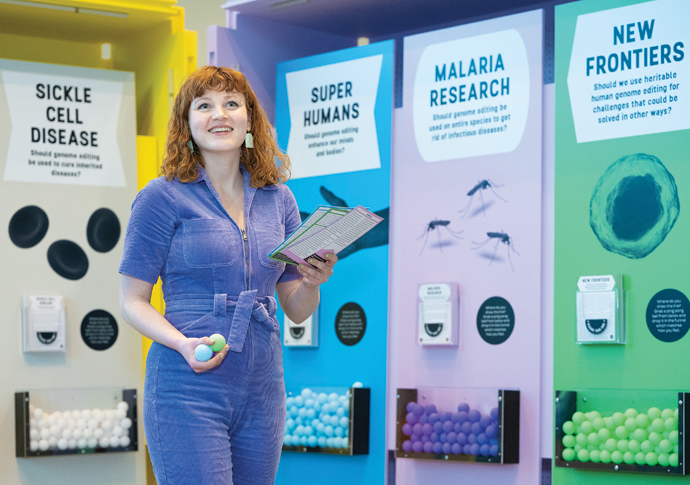Gene Genies?
A new exhibition at The Crick asks (some) questions about the ethics of gene editing. Jane Clinton discovers that it’s a topic for debate
Thursday, 13th April 2023 — By Jane Clinton

The Cut + Paste exhibition is at The Crick
IF you had the chance to choose elements of yourself to pass down, what would they be? The shape of your nose or maybe the colour of your hair? But would it be right to design an “enhanced” version of yourself?
And what about our food? Should we, for example, be able to alter crops to make them resistant to disease? (Just last month the law changed to allow the commercial development of gene-edited food in England).
These are some of the questions posed at the Francis Crick Institute’s exhibition Cut + Paste, which looks at genome editing. But what is genome editing and should we be worried about it?
Inside almost every cell in your body there is a unique set of instructions called your genome, which is made up of DNA.
Like an instruction manual for the body, a genome is an organism’s complete set of genetic instructions and can influence things such as the colour of our hair and how likely we are to develop certain diseases.
Our body is constantly copying its genome as it grows and replaces cells.
Very occasionally during this copying process errors occur that can lead to diseases such as cancer.
Genome editing is a group of technologies that gives scientists the ability to alter an organism’s DNA. For some, genome editing has the “power to shape the future”. But the exhibition asks “whose vision of the future should it be?”
Voices included in Cut + Paste reflect, to some extent, the ethical complexity surrounding genome editing.
Victoria Gray, the first patient to be treated for sickle cell disease using genome editing techniques, says: “It’s wonderful. It’s the change l’ve been waiting on my whole life.”
However, the late Professor Stephen Hawking, warned of the temptation to create “superhumans”.
“Once such superhumans appear, there are going to be major political problems with the unimproved humans, who won’t be able to compete,” he wrote.
In 2018, the scientist He Jiankui caused global outrage when he announced he had edited the genes of twin girls before birth. He claimed he had made the twins and a third child, immune to HIV infection. Sacked by his university in China, he received a three-year prison sentence. He has now set up a research lab in Beijing.
In the UK it is not legal to use heritable genome editing – where the edit would affect all future generations – to alter an early embryo, eggs or sperm to prevent passing on a particular genetic condition.
A recent exhibition at the People’s Museum: Somers Town, created by campaigning group Stop Designer Babies, looked at the history of eugenics and “stock improvement”, directed at the working class.
Esther Leslie, professor of political aesthetics at Birkbeck, University of London, the academic lead at the museum told the New Journal: “Francis Crick was a eugenicist who believed that humans of different ‘races’ were not equal and that people who were ‘poorly endowed genetically’ should not be allowed to have ‘large numbers of unnecessary children’.”
Referring to the recent Third International Summit on Human Genome Editing which was held at the Crick in March, Leslie adds: “It seems apt, but also at least mildly concerning, that a building named after him hosted a major international conference on the contemporary version of eugenics, known as genome-editing.”
Some have also questioned why the Crick exhibition has no mention of the word “eugenics”.
Ruth Garde, creative producer for Cut + Paste, said: “Eugenics isn’t named directly because there wasn’t sufficient space in the exhibition to explain it accessibly with the necessary depth and nuance.
“Nonetheless the exhibition does engage with the topic, such as through quotations from disability justice activists, and inviting visitors to consider the work of geneticists who have expressed such ideas.
“The topic of eugenics is likely to be more explicitly explored later in the exhibition run, through an art commission currently in development.”
Rosie Waldron, head of public engagement at the Crick said: “Both our Cut + Paste exhibition, and the Human Genome Editing Summit hosted at the Crick, are an important opportunity for researchers and the public to discuss and debate the ethical and appropriate use of genome editing tools in society.
“It’s vital that we open up this conversation and make these topics as engaging and accessible as possible to ensure that anyone can contribute their thoughts and opinions. In particular, we’re working in collaboration with people with lived experiences of genetic conditions, to present a balanced and inclusive range of opinions and perspectives.
“Ultimately, it should be for society to decide if and how genome editing techniques should be applied in treating genetic conditions and tackling other global issues.”
Perhaps the most affecting words included in the exhibition come from Rebecca Cokley, first disability rights programme officer at the Ford Foundation, New York: “Many of us see our disabilities as a rich and diverse culture, many of us want to pass that culture down to our children through our genes, and many of us see no reason not to.”
• Cut + Paste, created in partnership with The Liminal Space, is at the Francis Crick Institute until December 2. See www.crick.ac.uk/whats-on/exhibitions/cut-paste